15th March 2013 Yerevan, Armenia
Interview with David Dowell, good friend of Armenia
Following the earthquake in Armenia in December 1988, Mrs Thatcher – the British Prime Minister – promised to rebuild one of the schools in Gyumri. Donations came from the British government, British business and the British people. David Dowell ran one of the companies that agreed to help the project. He spoke to Kathy Leach as they travelled together to Gyumri to visit the school at the end of January 2013.
We are now fundraising to help the school – please contact Nune Hovsepyan at Nune.Hovsepyan@fco.gov.uk for more information if you would like to make a donation.
How did you first get involved with the Byron school project?
I used to own one of Europe’s largest roofing contractors. After the Armenian earthquake in 1988, we were contacted by the Department for Education who asked us to help build this school. I have to confess I didn’t really know where Armenia was in those days. I first came out in 1990 when the steelworkers were already putting up the steel and our job was to put the roof on top.
We were told was that there were 37 schools in Gyumri – and 34 had been destroyed in the earthquake. There were still collapsed buildings all around – you could see the white crosses on the rubble. I jumped at the idea of helping – like the other companies involved, we did it ‘for love’ (i.e. not for profit). And then the next time I came back I brought my children’s second-hand clothes – I felt obligated to try and help the people. And it grew from that to shipping out container loads – that’s how I started coming back and forth.
So having finished the roofing job, you felt you wanted to carry on helping?
Everyone in those days lived in metal containers – they were horrendous! Of course people looked after their homes to a standard my mother would have been proud of – with every possession they had been able to retrieve, even pianos! But a steel box is still a steel box – I believe there are still some people living in them today.
Were you there when the school was officially opened?
Yes. Margaret Thatcher was allowed to fly in to Leninakan airport in her VC10 RAF transport. The road from the airport to the school was asphalted – and all the trees leading up to the school were pruned in her honour. She was over an hour late arriving at the school because of the huge numbers of people lining the route wanting to see her. She eventually got there and was mobbed every step of the way – a British Prime Minister turning up in Gyumri! People just really wanted to thank her for donating the school.
The school was originally designed for around 400 children – with different blocks linked by open areas which could act as play areas in the winter months. But the school was in such great demand – great teachers and this wonderful building – that they worked in shifts, and converted these open areas into classrooms. It was an academically high achieving school – I know quite a few of the youngsters who have now achieved great things.
The school was designed to use all the latest cutting-edge technology – copper-wire around the water pipes to stop them freezing, solar panels to power the Acorn computers – but then there was the energy crisis from 1991.
There were two problems really – one was that the electicity was cut off, but the other was that the heating was designed as an oil-fired system. Oil was a scarce commodity here for a long time. I shipped out here as a stop-gap big paraffin-fired heaters – they were roaring away in the classroom, but were very noisy and made the classrooms very damp.
So now the school hasn’t had a proper working heating system for many years…
In retrospect I think we made the mistake of putting in something too complex, and didn’t forsee the budgetary requirement to maintain it. It’s easy to see this with hindsight, but I don’t think any of us on the opening day had the slightest thought that there would be a problem in the future.
It’s the classic mistake donors make time and time again – they want to provide the best of something, but then don’t provide for its maintenance.
Yes, for example, we provided white boards in the classroom – and didn’t imagine that there would be a terrible problem getting hold of felt pens for these boards. So that was another item I had to bring out.
So were these your personal donations, buying and bringing out all this equipment?
I’d hate anyone to think the major donations were mine, but a few things like bits of copper pipe, x-ray machines, bicycles….I used to write begging letters [to UK companies] asking for donations. Car tyres was another thing – I used to bring out 400 car tyres at a time.
How on earth did you import 400 car tyres to Armenia?
When I retired in 1997, I was asked if I’d like to run a local airfield. Honda car company used to come to the airfield to do test runs of other people’s cars – then they would shred the barely used tires. I asked if they would donate them to me, to take to Armenia. I had a hangar at the airfield which was my store, and when I had enough, and had the funding to ship it, I would fill a container.
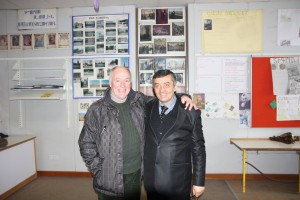 Various people sponsored containers – my wife and I, the tiling company which had supplied the school, my previous roofing company, George and Diana Kurkjian, Dr Ara Nahabedian and his family who collected so much, the AGBU – I got everyone involved. It cost $6000 a time. I usually sent one or two a year – the biggest consignment was nine in one go.
Various people sponsored containers – my wife and I, the tiling company which had supplied the school, my previous roofing company, George and Diana Kurkjian, Dr Ara Nahabedian and his family who collected so much, the AGBU – I got everyone involved. It cost $6000 a time. I usually sent one or two a year – the biggest consignment was nine in one go.
This is now about my 53rd or 54th visit to Armenia. – I did about 47 aid trips altogether. The first ones were two sports bags of clothes – then I told people about it in my village and it became four bags the next time. That’s how it started. And I became more emotionally involved with the country…I became a victim of Armenian hospitality!
And of course then one feels one wants to repay that hospitality!
Yes, absolutely.
What’s the next stage in the story? I heard there was an attempt to solve the heating problem in the early 2000s with another boiler – but that didn’t work. What was the problem?
I don’t know – I’m not a technician on boilers! I was at the school and understood there was a problem – I was taken to the boiler house to see what they were trying to do. I would hate anyone to think that no-one has made an effort to help the school until now – but the efforts that were made came up against different problems. For a start, the whole system was a British system with parts based on British imperial measurements [not metric]. That’s why, for example, I had to bring copper pipe from the UK – they couldn’t source it here.
So what has happened in the last few years with your involvement with Armenia?
I stopped delivering aid in large quantities after the law was changed and aid was taxed – I think that happened in 2003. So now I come back at least once a year to visit my former interpreters, aid recipients, and the school. Most of my interpreters are now married, with children. I let everyone in the UK know that I’m coming and take presents from people – I’ve got something for one of the English teachers at the Lord Byron School from the Holgate School in Nottingham [which also has a Byron connection]. We used to raise funding to take the children from Gyumri to Nottingham from time to time.
So that’s what I do now – deliver presents and drink cognac.
Like Father Christmas! To make all those trips over the last 23 years – something touched you very deeply about the people, about the country all those years ago.
Let me tell you a quick story. While we were building the school, all the people living in these horrible metal containers kept inviting us to come to their home, to come and have a drink. But we were on a tight timescale – we had to get the school ready for Mrs Thatcher to come and open it in June 1990. So we worked six days a week. Then one Sunday I agreed to go to the domik of a man and his wife. They kept it nice and clean – and there was an extraordinary revolving bright-coloured table lamp on the table. To say something friendly I pointed at it and said ‘lav e, shat lav e’. And when I came to go there was a sack at the door – with the lampshade in it – which I didn’t have the heart to refuse. We still have it to this day.
Such generosity, at a time of such privation…
I’m not a writer, but I wrote a few articles about Armenia during those years and I wrote: ‘We have everything. They have nothing. And yet they have what we have lost’. I was trying to say that the Armenian people have very close-knit families. My kids are probably already planning which old people’s home to put me in! But in Armenia they look after each other. I feel we’ve lost that. And that’s what attracted me to the place – not just their plight, but their warmth.
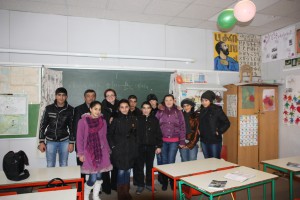
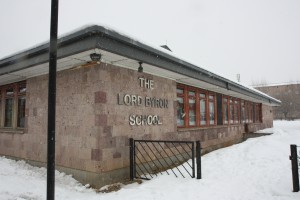
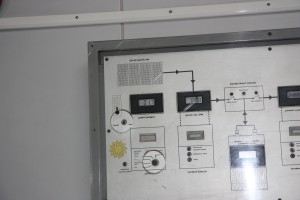
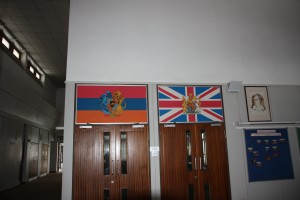
Dear Sir Jonathan James Aves,
dear Mr. David , it ´s great for me to comment an interview. For it ´s mor “full of life as an ordinary report. But this one is also very long. So I only pick up the three to me most important “Q ´s ” and “A ´s”. These are # 3: “where you there,,,? # 5: The wrong opinion by making donations… and # 12: Writing about the situation in Armenia means also DRAWING ATTENTION to the problems of this poor nation. Best wishes, Ingo-Steven Wais, Stuttgart/Germany
I visited the Gyumri school back in 2006 and I will never forget the warmth of the appreciation from the teachers and students for the help they received from the UK.